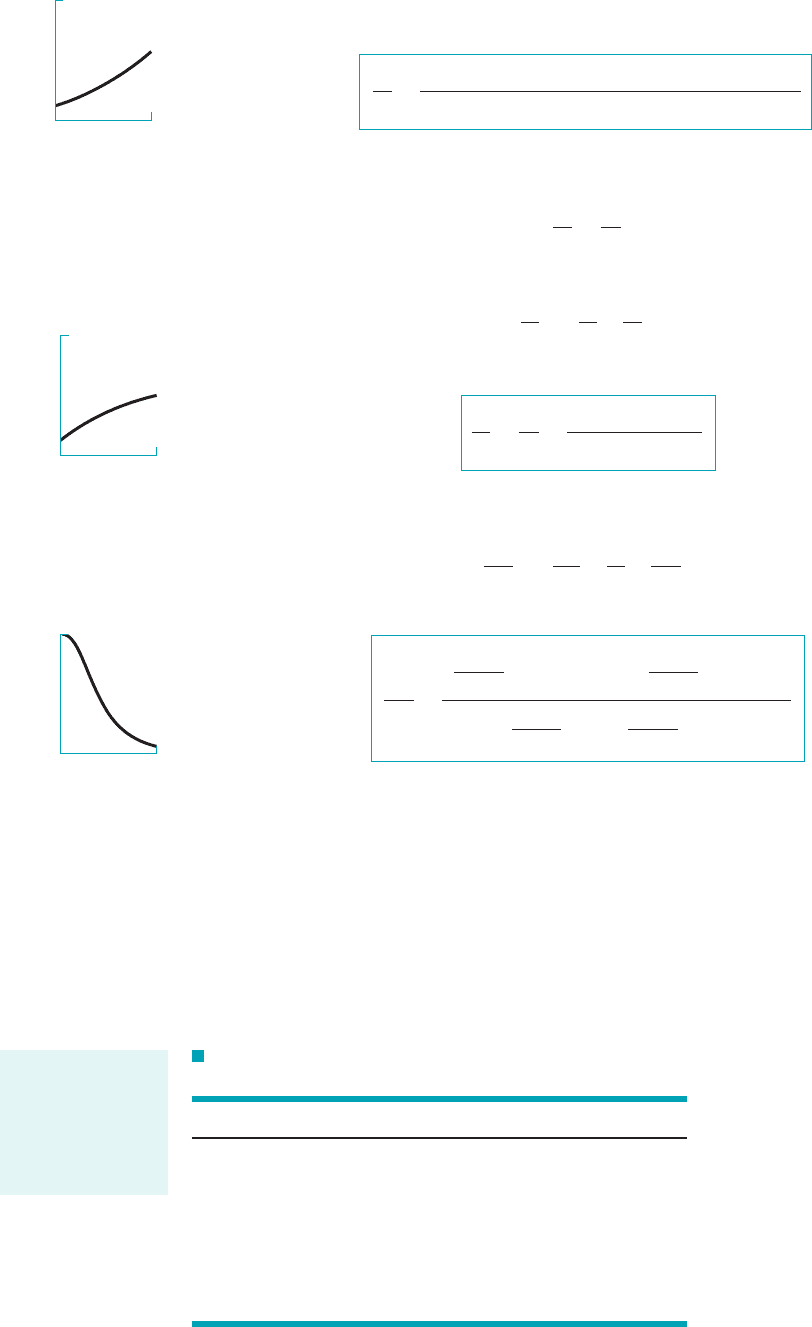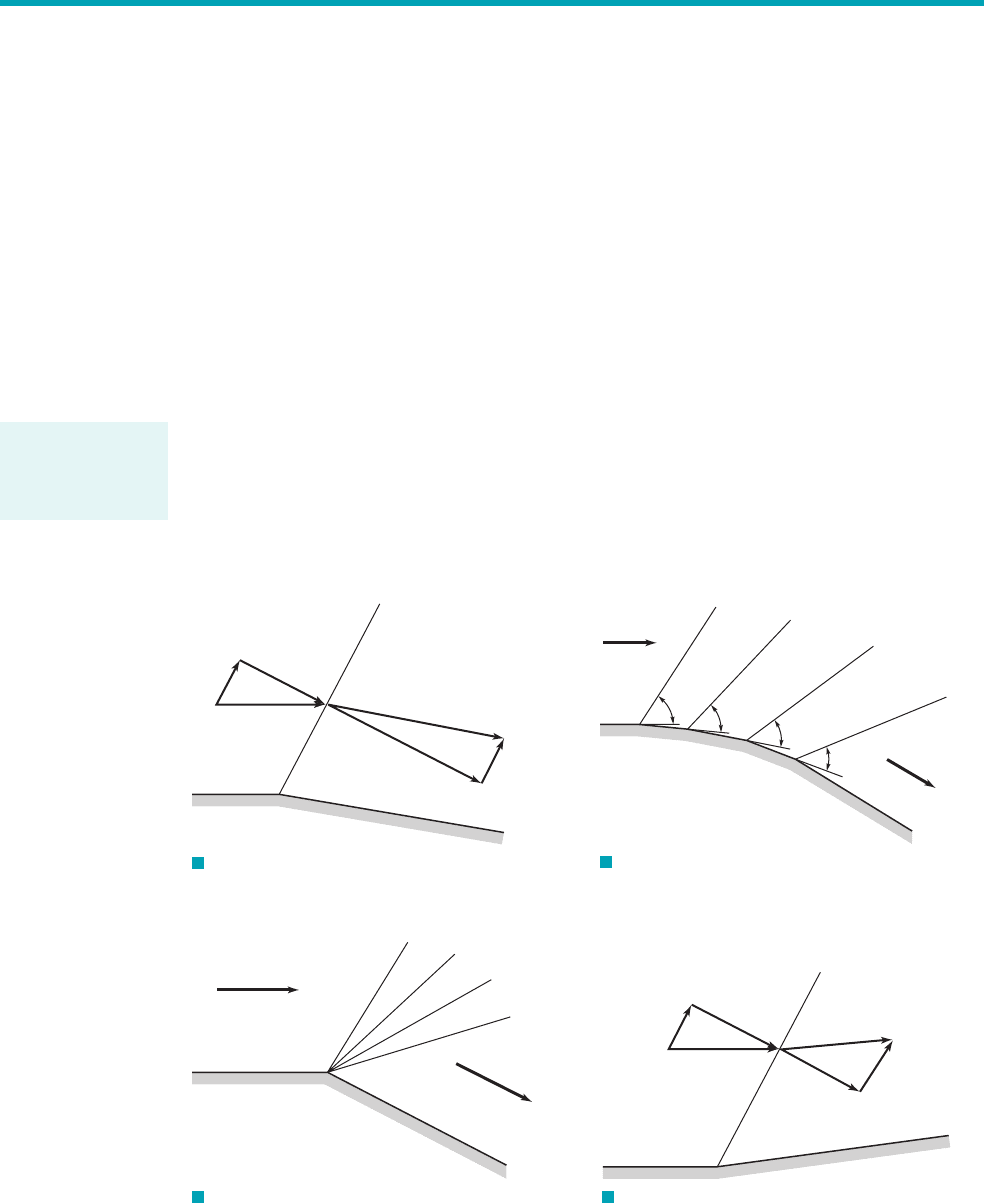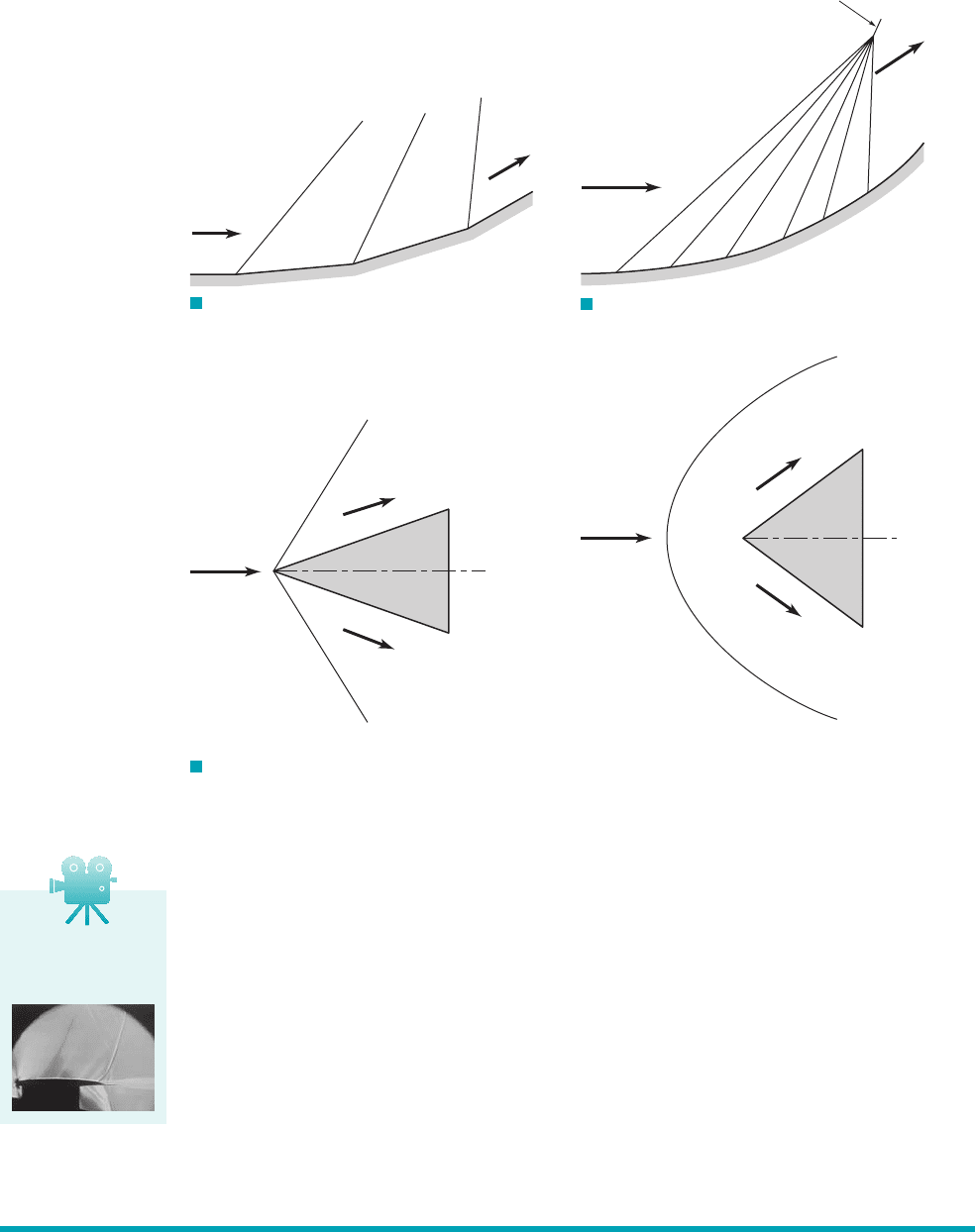Munson B.R. Fundamentals of Fluid Mechanics
Подождите немного. Документ загружается.


For the control volume containing the normal shock, no shaft work is involved and the heat
transfer is assumed negligible. Thus, the energy equation 1Eq. 5.692can be applied to steady gas
flow through the control volume of Fig. 11.24 to obtain
or, for an ideal gas, since and
(11.136)
Equation 11.136 is identical to the energy equation for Fanno flow analyzed earlier 1Eq. 11.752.
The T ds relationship previously used for ideal gas flow 1Eq. 11.222is valid for the
flow through the normal shock 1Fig. 11.242because it 1Eq. 11.222is an ideal gas property rela-
tionship.
From the analyses in the previous paragraphs, it is apparent that the steady flow of an
ideal gas across a normal shock is governed by some of the same equations used for describ-
ing both Fanno and Rayleigh flows 1energy equation for Fanno flows and momentum equation
for Rayleigh flow2. Thus, for a given density–velocity product gas 1R, k2, and conditions
at the inlet of the normal shock the conditions downstream of the shock 1state y2
will be on both a Fanno line and a Rayleigh line that pass through the inlet state 1state x2, as is
illustrated in Fig. 11.25. To conform with common practice we designate the states upstream
and downstream of the normal shock with x and y instead of numerals 1 and 2. The Fanno and
Rayleigh lines describe more of the flow field than just in the vicinity of the normal shock when
Fanno and Rayleigh flows are actually involved 1solid lines in Figs. 11.26a and 11.26b2. Other-
wise, these lines 1dashed lines in Figs. 11.26a, 11.26b, and 11.26c2are useful mainly as a way
to better visualize how the governing equations combine to yield a solution to the normal shock
flow problem.
The second law of thermodynamics requires that entropy must increase across a normal shock
wave. This law and sketches of the Fanno line and Rayleigh line intersections, like those of Figs.
11.25 and 11.26, persuade us to conclude that flow across a normal shock can only proceed from
supersonic to subsonic flow. Similarly, in open-channel flows 1see Chapter 102the flow across a hy-
draulic jump proceeds from supercritical to subcritical conditions.
Since the states upstream and downstream of a normal shock wave are represented by the
supersonic and subsonic intersections of actual and兾or imagined Fanno and Rayleigh lines, we
should be able to use equations developed earlier for Fanno and Rayleigh flows to quantify nor-
mal shock flow. For example, for the Rayleigh line of Fig. 11.26b
(11.137)
p
y
p
x
⫽ a
p
y
p
a
b a
p
a
p
x
b
1T
x
, p
x
, and s
x
2,
1rV2,
T ⫹
1rV2
2
T
2
2c
p
1p
2
Ⲑ
R
2
2
⫽ T
0
⫽ constant
p ⫽ rRTh
ˇ
⫺ h
ˇ
0
⫽ c
p
1T ⫺ T
0
2
h
ˇ
⫹
V
2
2
⫽ h
ˇ
0
⫽ constant
11.5 Nonisentropic Flow of an Ideal Gas 627
Section (x)
Supersonic
flow
Subsonic
flow
Infinitesimally thin
control volume
Normal shock wave
Diverging
duct
Section (
y)
F I G U R E 11.24 Normal shock
control volume.
The energy equa-
tion for Fanno flow
and the momentum
equation for
Rayleigh flow are
valid for flow
across normal
shocks.
T
s
x
y
Normal shock
Fanno line
Rayleigh line
F I G U R E 11.25 The
relationship between a normal shock and
Fanno and Rayleigh lines.
JWCL068_ch11_579-644.qxd 9/25/08 8:24 PM Page 627

But from Eq. 11.123 for Rayleigh flow we get
(11.138)
and
(11.139)
Thus, by combining Eqs. 11.137, 11.138, and 11.139 we get
(11.140)
Equation 11.140 can also be derived starting with
and using the Fanno flow equation 1Eq. 11.1072
As might be expected, Eq. 11.140 can be obtained directly from the linear momentum equation
since
For the Fanno flow of Fig. 11.26a,
(11.141)
T
y
T
x
⫽ a
T
y
T*
b a
T*
T
x
b
rV
2
Ⲑ
p ⫽ V
2
Ⲑ
RT ⫽ kV
2
Ⲑ
RTk ⫽ k Ma
2
.
p
x
⫹ r
x
V
x
2
⫽ p
y
⫹ r
y
V
y
2
p
p*
⫽
1
Ma
e
1k ⫹ 12
Ⲑ
2
1 ⫹ 31k ⫺ 12
Ⲑ
24Ma
2
f
1
Ⲑ
2
p
y
p
x
⫽ a
p
y
p*
b a
p*
p
x
b
p
y
p
x
⫽
1 ⫹ kMa
x
2
1 ⫹ kMa
y
2
p
x
p
a
⫽
1 ⫹ k
1 ⫹ kMa
x
2
p
y
p
a
⫽
1 ⫹ k
1 ⫹ kMa
y
2
628 Chapter 11 ■ Compressible Flow
F I G U R E 11.26 (a) The normal
shock in a Fanno flow. (b) The normal shock in a
Rayleigh flow. (c) The normal shock in a friction-
less and adiabatic flow.
T
s
(a)
p
0, x
p*
p
0, y
T
0
=
constant
T* =
constant
y
x
Normal shock
Fanno line
T
s
(c)
p
0, x
p
0, y
T
0
y
x
Normal shock
T
s
(b)
p
a
T
a
y
b
a
x
Normal shock
Rayleigh line
Ratios of thermody-
namic properties
across a normal
shock are functions
of the Mach
numbers.
JWCL068_ch11_579-644.qxd 9/25/08 8:25 PM Page 628

From Eq. 11.101 for Fanno flow we get
(11.142)
and
(11.143)
A consolidation of Eqs. 11.141, 11.142, and 11.143 gives
(11.144)
We seek next to develop an equation that will allow us to determine the Mach number down-
stream of the normal shock, when the Mach number upstream of the normal shock, is
known. From the ideal gas equation of state 1Eq. 11.12, we can form
(11.145)
Using the continuity equation
with Eq. 11.145 we obtain
(11.146)
When combined with the Mach number definition 1Eq. 11.462and the ideal gas speed-of-sound
equation 1Eq. 11.362, Eq. 11.146 becomes
(11.147)
Thus, Eqs. 11.147 and 11.144 lead to
(11.148)
which can be merged with Eq. 11.140 to yield
(11.149)
This relationship is graphed in the margin for air.
Thus, we can use Eq. 11.149 to calculate values of Mach number downstream of a normal
shock from a known Mach number upstream of the shock. As suggested by Fig. 11.26, to have a
normal shock we must have From Eq. 11.149 we find that
If we combine Eqs. 11.149 and 11.140, we get
(11.150)
This relationship is graphed in the margin for air.
p
y
p
x
⫽
2k
k ⫹ 1
Ma
x
2
⫺
k ⫺ 1
k ⫹ 1
Ma
y
6 1.Ma
x
7 1.
Ma
y
2
⫽
Ma
x
2
⫹ 32
Ⲑ
1k ⫺ 124
32k
Ⲑ
1k ⫺ 124Ma
x
2
⫺ 1
p
y
p
x
⫽ e
1 ⫹ 31k ⫺ 12
Ⲑ
24Ma
x
2
1 ⫹ 31k ⫺ 12
Ⲑ
24Ma
y
2
f
1
Ⲑ
2
Ma
x
Ma
y
p
y
p
x
⫽ a
T
y
T
x
b
1
Ⲑ
2
a
Ma
x
Ma
y
b
p
y
p
x
⫽ a
T
y
T
x
b a
V
x
V
y
b
r
x
V
x
⫽ r
y
V
y
p
y
p
x
⫽ a
T
y
T
x
b a
r
y
r
x
b
Ma
x
,Ma
y
,
T
y
T
x
⫽
1 ⫹ 31k ⫺ 12
Ⲑ
24Ma
x
2
1 ⫹ 31k ⫺ 12
Ⲑ
24Ma
y
2
T
x
T*
⫽
1k ⫹ 12
Ⲑ
2
1 ⫹ 31k ⫺ 12
Ⲑ
24Ma
x
2
T
y
T*
⫽
1k ⫹ 12
Ⲑ
2
1 ⫹ 31k ⫺ 12
Ⲑ
24Ma
y
2
11.5 Nonisentropic Flow of an Ideal Gas 629
1.0
0.0
5.01.0
Ma
x
Ma
y
The flow changes
from supersonic to
subsonic across a
normal shock.
40
0.0
5.01.0
Ma
x
p
y
___
p
x
JWCL068_ch11_579-644.qxd 9/25/08 8:25 PM Page 629

This equation allows us to calculate the pressure ratio across a normal shock from a known up-
stream Mach number. Similarly, taking Eqs. 11.149 and 11.144 together we obtain
(11.151)
This relationship is graphed in the margin for air.
From the continuity equation 1Eq. 11.402, we have for flow across a normal shock
(11.152)
and from the ideal gas equation of state 1Eq. 11.12
(11.153)
Thus, by combining Eqs. 11.152, 11.153, 11.150, and 11.151, we get
(11.154)
This relationship is graphed in the margin for air.
The stagnation pressure ratio across the shock can be determined by combining
(11.155)
with Eqs. 11.59, 11.149, and 11.150 to get
(11.156)
This relationship is graphed in the margin for air.
Figure D.4 in Appendix D graphs values of downstream Mach numbers, pressure ratio,
temperature ratio, density ratio, , or velocity ratio, and stagnation pres-
sure ratio, as a function of upstream Mach number, for the steady flow across a nor-
mal shock wave of an ideal gas having a specific heat ratio These values were calculated
from Eqs. 11.149, 11.150, 11.151, 11.154, and 11.156.
Important trends associated with the steady flow of an ideal gas across a normal shock wave
can be determined by studying Fig. D.4. These trends are summarized in Table 11.3.
Examples 11.17 and 11.18 illustrate how Fig. D.4 can be used to solve fluid flow problems
involving normal shock waves.
k ⫽ 1.4.
Ma
x
,p
0,y
Ⲑ
p
0,x
,
V
x
Ⲑ
V
y
,r
y
Ⲑ
r
x
T
y
Ⲑ
T
x
,p
y
Ⲑ
p
x
,
Ma
y
,
p
0,y
p
0,x
⫽
a
k ⫹ 1
2
Ma
x
2
b
k
Ⲑ
1k⫺12
a1 ⫹
k ⫺ 1
2
Ma
x
2
b
k
Ⲑ
11⫺k2
a
2k
k ⫹ 1
Ma
x
2
⫺
k ⫺ 1
k ⫹ 1
b
1
Ⲑ
1k⫺12
p
0,y
p
0,x
⫽ a
p
0,y
p
y
b a
p
y
p
x
b a
p
x
p
0,x
b
r
y
r
x
⫽
V
x
V
y
⫽
1k ⫹ 12Ma
x
2
1k ⫺ 12Ma
x
2
⫹ 2
r
y
r
x
⫽ a
p
y
p
x
b a
T
x
T
y
b
r
y
r
x
⫽
V
x
V
y
T
y
T
x
⫽
51 ⫹ 31k ⫺ 12
Ⲑ
24Ma
x
2
6532k
Ⲑ
1k ⫺ 124Ma
x
2
⫺ 16
51k ⫹ 12
2
Ⲑ
321k ⫺ 1246Ma
x
2
630 Chapter 11 ■ Compressible Flow
10
0.0
5.01.0
Ma
x
T
y
___
T
x
10
0.0
5.01.0
Ma
x
,
V
x
___
V
y
y
___
x
ρ
ρ
TABLE 11.3
Summary of Normal Shock Wave Characteristics
Variable Change Across Normal Shock Wave
Mach number Decrease
Static pressure Increase
Stagnation pressure Decrease
Static temperature Increase
Stagnation temperature Constant
Density Increase
Velocity Decrease
Across a normal
shock the values of
some parameters
increase, some re-
main constant, and
some decrease.
1.0
0.0
5.01.0
Ma
x
p
0,y
____
p
0,x
JWCL068_ch11_579-644.qxd 9/25/08 8:25 PM Page 630

11.5 Nonisentropic Flow of an Ideal Gas 631
GIVEN Designers involved with fluid mechanics work hard at
minimizing loss of available energy in their designs. Adiabatic,
frictionless flows involve no loss in available energy. Entropy
remains constant for these idealized flows. Adiabatic flows with
friction involve available energy loss and entropy increase. Gen-
erally, larger entropy increases imply larger losses.
Stagnation Pressure Drop across a Normal Shock
E
XAMPLE 11.17
S
OLUTION
tion pressure drop across the shock is appreciable. If a shock oc-
curs at only about 50% of the upstream stagnation
pressure is recovered.
In devices where supersonic flows occur, for example, high-
performance aircraft engine inlet ducts and high-speed wind tun-
nels, designers attempt to prevent shock formation, or if shocks
must occur, they design the flow path so that shocks are posi-
tioned where they are weak 1small Mach number2.
Of interest also is the static pressure rise that occurs across a
normal shock. These static pressure ratios, obtained from
Fig. D.4 are shown in the table for a few Mach numbers. For a de-
veloping boundary layer, any pressure rise in the flow direction is
considered as an adverse pressure gradient that can possibly cause
flow separation 1see Section 9.2.62. Thus, shock–boundary layer
interactions are of great concern to designers of high-speed flow
devices.
p
y
Ⲑ
p
x
,
Ma
x
⫽ 2.5,
We assume that air behaves as a typical gas and use Fig.
D.4 to respond to the above-stated requirements. Since
we can construct the following table with values of
from Fig. D.4.
COMMENT When the Mach number of the flow entering the
shock is low, say the flow across the shock is nearly
isentropic and the loss in stagnation pressure is small. However,
as shown in Fig. E11.17, at larger Mach numbers, the entropy
change across the normal shock rises dramatically and the stagna-
Ma
x
⫽ 1.2,
p
0,y
Ⲑ
p
0,x
1 ⫺
p
0,y
p
0,x
⫽
p
0,x
⫺ p
0,y
p
0,x
1k ⫽ 1.42
FIND For normal shocks, show that the stagnation pressure
drop 1and thus loss2is larger for higher Mach numbers.
1.0 1.0 0
1.2 0.99 0.01
1.5 0.93 0.07
2.0 0.72 0.28
2.5 0.50 0.50
3.0 0.33 0.67
3.5 0.21 0.79
4.0 0.14 0.86
5.0 0.06 0.94
p
0,x
p
0,y
Ⲑ
p
0,x
Ma
x
p
0,x
p
0,y
1.0 1.0
1.2 1.5
1.5 2.5
2.0 4.5
3.0 10
4.0 18
5.0 29
p
y
Ⲑ
p
x
Ma
x
0
0123456
0.2
0.4
0.6
0.8
1
p
0,x
–
p
0,y
_________
p
0,x
Ma
x
F I G U R E E11.17
GIVEN A total pressure probe is inserted into a supersonic air
flow. A shock wave forms just upstream of the impact hole and
head as illustrated in Fig. E11.18. The probe measures a total
pressure of 60 psia. The stagnation temperature at the probe head
is The static pressure upstream of the shock is measured
with a wall tap to be 12 psia.
FIND Determine the Mach number and velocity of the flow.
1000 °R.
Supersonic Flow Pitot Tube
E
XAMPLE 11.18
Wall static pressure tap
Supersonic
flow
Stagnation
pathline
Total
pressure probe
Shock
wave
xy
F I G U R E E11.18
JWCL068_ch11_579-644.qxd 9/25/08 8:25 PM Page 631

632 Chapter 11 ■ Compressible Flow
S
OLUTION
The stagnation temperature downstream of the shock was mea-
sured and found to be
Since the stagnation temperature remains constant across a nor-
mal shock 1see Eq. 11.1362,
For the isentropic flow upstream of the shock, Eq. 11.56 or
Fig. D.1 can be used. For
or
With Eq. 3 we obtain
(Ans)
COMMENT Application of the incompressible flow Pitot
tube results 1see Section 3.52would give highly inaccurate
results because of the large pressure and density changes
involved.
⫽ 2220 ft
Ⲑ
s
⫽ 392 1ft
#
lb
Ⲑ
lbm2
1
Ⲑ
2
3132.2 lbm
#
ft
Ⲑ
s
2
2
Ⲑ
lb4
1
Ⲑ
2
V
x
⫽ 1.87 2353.3 1ft
#
lb2
Ⲑ
1lbm
#
°R241590 °R211.42
T
x
⫽ 10.59211000 °R2⫽ 590 °R
T
x
T
0,x
⫽ 0.59
Ma
x
⫽ 1.9,
T
0,x
⫽ T
0,y
⫽ 1000 °R
T
0,y
⫽ 1000 °R
We assume that the flow along the stagnation pathline is isen-
tropic except across the shock. Also, the shock is treated as a nor-
mal shock. Thus, in terms of the data we have
(1)
where is the stagnation pressure measured by the probe, and
is the static pressure measured by the wall tap. The stagnation
pressure upstream of the shock, is not measured.
Combining Eqs. 1, 11.156, and 11.59 we obtain
(2)
which is called the Rayleigh Pitot-tube formula. Values of
from Eq. 2 are considered important enough to be included in Fig.
D.4 for Thus, for and
we use Fig. D.4 1or Eq. 22to ascertain that
(Ans)
To determine the flow velocity we need to know the static tem-
perature upstream of the shock, since Eqs. 11.36 and 11.46 can be
used to yield
(3)V
x
⫽ Ma
x
c
x
⫽ Ma
x
1RT
x
k
Ma
x
⫽ 1.9
p
0,y
p
x
⫽
60 psia
12 psia
⫽ 5
k ⫽ 1.4k ⫽ 1.4.
p
0,y
Ⲑ
p
x
p
0,y
p
x
⫽
531k ⫹ 12
Ⲑ
24Ma
x
2
6
k
Ⲑ
1k⫺12
532k
Ⲑ
1k ⫹ 124Ma
x
2
⫺ 31k ⫺ 12
Ⲑ
1k ⫹ 1246
1
Ⲑ
1k⫺12
p
0,x
,
p
x
p
0,y
p
0,y
p
x
⫽ a
p
0,y
p
0,x
b a
p
0,x
p
x
b
GIVEN Consider the converging–diverging duct of Example
11.8.
FIND Determine the ratio of back pressure to inlet stagnation
pressure, 1see Fig. 11.132, that will result in a standingp
III
Ⲑ
p
0,x
normal shock at the exit of the duct. What value of
the ratio of back pressure to inlet stagnation pressure would be
required to position the shock at Show related
temperature–entropy diagrams for these flows.
x ⫽⫹0.3 m?
1x ⫽⫹0.5 m2
Normal Shock in a Converging–Diverging Duct
E
XAMPLE 11.19
S
OLUTION
Thus,
(Ans)
When the ratio of duct back pressure to inlet stagnation pressure,
is set equal to 0.36, the air will accelerate through the
converging–diverging duct to a Mach number of 2.8 at the duct
exit. The air will subsequently decelerate to a subsonic flow
across a normal shock at the duct exit. The stagnation pressure
ratio across the normal shock, is 0.38 1Fig. D.4 forp
0,y
Ⲑ
p
0,x
,
p
III
Ⲑ
p
0,x
,
⫽ 0.36 ⫽
p
III
p
0,x
p
y
p
0,x
⫽ a
p
y
p
x
b a
p
x
p
0,x
b⫽ 19.0210.042
For supersonic, isentropic flow through the nozzle to just up-
stream of the standing normal shock at the duct exit, we have
from the table of Example 11.8 at
and
From Fig. D.4 for we obtain
p
y
p
x
⫽ 9.0
Ma
x
⫽ 2.8
p
x
p
0,x
⫽ 0.04
Ma
x
⫽ 2.8
x ⫽⫹0.5 m
JWCL068_ch11_579-644.qxd 9/25/08 8:26 PM Page 632

11.6 Analogy between Compressible and Open-Channel Flows 633
2. A considerable amount of available energy is lost
across the shock.
For a normal shock at we note from the table of
Example 11.8 that and
(1)
From Fig. D.4 for we obtain ,
and
(2)
From Fig. D.1 for we get
(3)
For the ratio of duct exit area to local area
is, using the area equation from Example 11.8,
(4)
Using Eqs. 3 and 4 we get
A
2
A*
⫽ a
A
y
A*
b a
A
2
A
y
b⫽ 11.24211.8422⫽ 2.28
A
2
A
y
⫽
0.1 ⫹ 10.52
2
0.1 ⫹ 10.32
2
⫽ 1.842
1A
2
Ⲑ
A
y
2x ⫽⫹0.3 m,
A
y
A*
⫽ 1.24
Ma
y
⫽ 0.56
p
0,y
p
0,x
⫽ 0.66
Ma
y
⫽ 0.56p
y
Ⲑ
p
x
⫽ 5.2,Ma
x
⫽ 2.14
p
x
p
0,x
⫽ 0.10
Ma
x
⫽ 2.14
x ⫽⫹0.3 m,
Ma
x
⫽ 2.8
Note that for the isentropic flow upstream of the shock,
1the actual throat area2, while for the isentropic flow down-
stream of the shock, 2.28⫽0.15 m
2
. With
we use Fig. D.1 and find and
(5)
Combining Eqs. 2 and 5 we obtain
(Ans)
When the back pressure, is set equal to 0.63 times the inlet
stagnation pressure, the normal shock will be positioned at
The corresponding T–s diagrams are shown in
Figs. E11.19a and E11.19b.
COMMENT Note that is less than the value of
this ratio for subsonic isentropic flow through the converging–
diverging duct, 1from Example 11.82and is larger
than for duct flow with a normal shock at the exit
1see Fig. 11.132. Also the stagnation pressure ratio with the shock
at is much greater than the stagna-
tion pressure ratio, 0.38, when the shock occurs at the exit
of the duct.1x ⫽⫹0.5 m2
⫹0.3 m, p
0,y
Ⲑ
p
0,x
⫽ 0.66,x ⫽
p
III
Ⲑ
p
0,x
⫽ 0.36,
⫽ 0.98p
2
Ⲑ
p
0
p
2
Ⲑ
p
0,x
⫽ 0.63
x ⫽⫹0.3 m.
p
0,x
,
p
2
,
p
2
p
0,x
⫽ a
p
2
p
0,y
b a
p
0,y
p
0,x
b⫽ 10.95210.662⫽ 0.63
p
2
p
0,y
⫽ 0.95
Ma
2
⫽ 0.26A
2
Ⲑ
A* ⫽ 2.28
A* ⫽ A
2
Ⲑ
2.28 ⫽ 0.35 m
2
Ⲑ
0.10 m
2
A* ⫽
F I G U R E E11.19
340
300
260
220
180
140
100
0 80 160 240 320 400 480 0 80 160 240 320 400 480
x
x
p
x
= 4 kPa (abs)
p
0, x
= 101 kPa (abs)
Shock at nozzle exit plane (
x = 0.5 m)
p
0, y
= 38 kPa (abs)
p
y
=
36 kPa (abs)
=
p
III
0, y
0, x
y
, III
T
x
= 112 K
T
y
= 275 K
T
0, x
=
T
0,y
= 288 K
Normal shock
T, K
T, K
s – s
x
,
J
______
(kg
•
K)
s – s
x
,
J
______
(kg
•
K)
(
a)(b)
340
300
260
220
180
2
140
100
Shock within nozzle (x = 0.3 m)
T
x
= 150 K
p
x
= 10 kPa (abs)
p
y
= 52 kPa (abs)
T
y
= 271 K
T
2
= 284 K
Normal shock
0, y
0, x
y
T
0, x
= T
0,y
=
288 K
p
0, x
=
101 kPa (abs)
p
0, y
= 67 kPa (abs)
p
2
= 64 kPa (abs)
11.6 Analogy between Compressible and Open-Channel Flows
During a first course in fluid mechanics, students rarely study both open-channel flows 1Chap-
ter 102and compressible flows. This is unfortunate because these two kinds of flows are strik-
ingly similar in several ways. Furthermore, the analogy between open-channel and compressible
flows is useful because important two-dimensional compressible flow phenomena can be simply
JWCL068_ch11_579-644.qxd 9/25/08 8:27 PM Page 633

634 Chapter 11 ■ Compressible Flow
and inexpensively demonstrated with a shallow, open-channel flow field in a ripple tank or wa-
ter table.
The propagation of weak pressure pulses 1sound waves2in a compressible flow can be
considered to be comparable to the movement of small amplitude waves on the surface of an
open-channel flow. In each case—two-dimensional compressible flow and open-channel flow—
the influence of flow velocity on wave pattern is similar. When the flow velocity is less than
the wave speed, wave fronts can move upstream of the wave source and the flow is subsonic
1compressible flow2or subcritical 1open-channel flow2. When the flow velocity is equal to the
wave speed, wave fronts cannot move upstream of the wave source and the flow is sonic 1com-
pressible flow2or critical 1open-channel flow2. When the flow velocity is greater than the wave
speed, the flow is supersonic 1compressible flow2or supercritical 1open-channel flow2. Normal
shocks can occur in supersonic compressible flows. Hydraulic jumps can occur in supercritical
open-channel flows. Comparison of the characteristics of normal shocks 1Section 11.5.32and
hydraulic jumps 1Section 10.6.12suggests a strong resemblance and thus analogy between the
two phenomena.
For compressible flows a meaningful dimensionless variable is the Mach number, where
(11.46)
In open-channel flows, an important dimensionless variable is the Froude number, where
(11.157)
The velocity of the channel flow is the acceleration of gravity is g, and the depth of the flow
is y. Since the speed of a small amplitude wave on the surface of an open-channel flow, is 1see
Section 10.2.12
(11.158)
we conclude that
(11.159)
From Eqs. 11.46 and 11.159 we see the similarity between Mach number 1compressible flow2and
Froude number 1open-channel flow2.
For compressible flow, the continuity equation is
(11.160)
where V is the flow velocity, is the fluid density, and A is the flow cross-sectional area. For an
open-channel flow, conservation of mass leads to
(11.161)
where is the flow velocity, and y and b are the depth and width of the open-channel flow. Com-
paring Eqs. 11.160 and 11.161 we note that if flow velocities are considered similar and flow area,
A, and channel width, b, are considered similar, then compressible flow density, is analogous to
open-channel flow depth, y.
It should be pointed out that the similarity between Mach number and Froude number is gen-
erally not exact. If compressible flow and open-channel flow velocities are considered to be sim-
ilar, then it follows that for Mach number and Froude number similarity the wave speeds c and
must also be similar.
From the development of the equation for the speed of sound in an ideal gas 1see Eqs. 11.34
and 11.352we have for the compressible flow
(11.162)
From Eqs. 11.162 and 11.158, we see that if y is to be similar to as suggested by comparing Eq.
11.160 and 11.161, then k should be equal to 2. Typically or 1.67, not 2. This limitationk ⫽ 1.4
r
c ⫽ 21constant2 kr
k⫺1
c
oc
r,
V
oc
ybV
oc
⫽ constant
r
rAV ⫽ constant
Fr ⫽
V
oc
c
oc
c
oc
⫽ 1gy
c
oc
,
V
oc
,
Fr ⫽
V
oc
1gy
Ma ⫽
V
c
Compressible gas
flows and open-
channel liquid
flows are strikingly
similar in several
ways.
JWCL068_ch11_579-644.qxd 9/25/08 8:27 PM Page 634

11.7 Two-Dimensional Compressible Flow 635
A brief introduction to two-dimensional compressible flow is included here for those who are in-
terested. We begin with a consideration of supersonic flow over a wall with a small change of di-
rection as sketched in Fig. 11.27.
We apply the component of the linear momentum equation 1Eq. 5.222parallel to the Mach
wave to the flow across the Mach wave. 1See Eq. 11.39 for the definition of a Mach wave.2The
result is that the component of velocity parallel to the Mach wave is constant across the Mach
wave. That is, Thus, from the simple velocity triangle construction indicated in Fig.
11.27, we conclude that the flow accelerates because of the change in direction of the flow. If sev-
eral changes in wall direction are involved as shown in Fig. 11.28, then the supersonic flow accel-
erates 1expands2because of the changes in flow direction across the Mach waves 1also called
expansion waves2. Each Mach wave makes an appropriately smaller angle with the upstream wall
because of the increase in Mach number that occurs with each direction change 1see Section 11.32.
A rounded expansion corner may be considered as a series of infinitesimal changes in direction.
Conversely, even sharp corners are actually rounded when viewed on a small enough scale. Thus,
expansion fans as illustrated in Fig. 11.29 are commonly used for supersonic flow around a “sharp”
corner. If the flow across the Mach waves is considered to be isentropic, then Eq. 11.42 suggests
that the increase in flow speed is accompanied by a decrease in static pressure.
When the change in supersonic flow direction involves the change in wall orientation
sketched in Fig. 11.30, compression rather than expansion occurs. The flow decelerates and the
static pressure increases across the Mach wave. For several changes in wall direction, as indicated
in Fig. 11.31, several Mach waves occur, each at an appropriately larger angle with the upstream
wall. A rounded compression corner may be considered as a series of infinitesimal changes in
a
a
V
t1
⫽ V
t2
.
11.7 Two-Dimensional Compressible Flow
Expansion Mach wave
p
2
< p
1
V
2
> V
1
V
t2
= V
t1
V
n2
p
1
V
1
V
n1
V
t1
F I G U R E 11.27 Flow acceleration
across a Mach wave.
F I G U R E 11.28 Flow acceleration
across Mach waves.
Expansion Mach waves
α
1
α
2
α
3
α
4
to exactness is, however, usually not serious enough to compromise the benefits of the analogy
between compressible and open-channel flows.
F I G U R E 11.30 Flow deceleration
across a Mach wave.
Compression Mach wave
p
2
> p
1
V
2
< V
1
V
t2
= V
t1
V
n2
p
1
V
1
V
n1
V
t1
F I G U R E 11.29 Corner expansion
fan.
V
2
> V
1
V
1
Expansion fan
Supersonic flows
accelerate across
expansion Mach
waves.
JWCL068_ch11_579-644.qxd 9/25/08 8:27 PM Page 635

636 Chapter 11 ■ Compressible Flow
Compression Mach waves
F I G U R E 11.31 Flow decelera-
tion across Mach waves.
Attached
oblique shock
(a)
(b)
Detached
curved shock
F I G U R E 11.33 Supersonic flow over a wedge: (a) Smaller wedge angle results in
attached oblique shock. (b) Large wedge angle results in detached curved shock.
In this chapter, consideration is given to the flow of gas involving substantial changes in fluid
density caused mainly by high speeds. While the flow of liquids may most often be considered
of constant density or incompressible over a wide range of speeds, the flow of gases and vapors
11.8 Chapter Summary and Study Guide
Compression
Mach waves
V
2
< V
1
V
1
Oblique shock wave
F I G U R E 11.32 Oblique shock
wave.
direction and even sharp corners are actually rounded. Mach waves or compression waves can co-
alesce to form an oblique shock wave as shown in Fig. 11.32.
The above discussion of compression waves can be usefully extended to supersonic flow im-
pinging on an object. For example, for supersonic flow incident on a wedge-shaped leading edge
1see Fig. 11.332, an attached oblique shock can form as suggested in Fig. 11.33a. For the same in-
cident Mach number but with a larger wedge angle, a detached curved shock as sketched in Fig.
11.33b can result. A detached, curved shock ahead of a blunt object 1a sphere2is shown in the pho-
tograph at the beginning of this chapter. In Example 11.19, we considered flow along a stagnation
pathline across a detached curved shock to be identical to flow across a normal shock wave.
From this brief look at two-dimensional supersonic flow, one can easily conclude that the
extension of these concepts to flows over immersed objects and within ducts can be exciting,
especially if three-dimensional effects are considered. Reference 6 provides much more on this sub-
ject than could be included here.
V11.8 Two-
dimensional com-
pressible flow
JWCL068_ch11_579-644.qxd 9/25/08 8:27 PM Page 636
